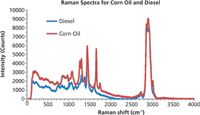Characterization of Diesel Fuel Using a Modular Raman System
Raman spectroscopy is an excellent technique for the identification and characterization of fuels. With no requirement for sample preparation and the power to identify and quantify materials, Raman has many uses across a range of industries.
Raman spectroscopy is an excellent technique for the identification and characterization of fuels. With no requirement for sample preparation and the power to identify and quantify materials, Raman has many uses across a range of industries.
Biodiesel is a nonpetroleum-based diesel fuel made from vegetable oil or animal fats. Biodiesel can be used in most diesel engines with little to no engine modification required, and can be blended with petroleum diesel fuel to provide a cleaner burning, lower emission diesel fuel.
As biodiesel production increases, Raman spectroscopy will become a useful analytical tool during the refining process to assess incoming raw materials, monitor the production process, and confirm the quality of the final product.
Measurement Conditions
Today's Raman measurement options range from handheld and benchtop systems such as the Ocean Optics IDRaman series, to modular, "build your own" Raman systems including spectrometers, lasers, probes, and sample holders.
The Raman measurements described here were made with a modular setup comprising the Maya2000 Pro-NIR spectrometer, a 785 nm Raman laser, a Raman-coupled probe for 785 nm Raman and a sample holder. Acquisition parameters were a 500 ms integration time with no scans averaged and no boxcar smoothing. Samples of corn oil (sometimes used as a diesel alternative) and petroleum-based diesel were placed in small glass vials for analysis.
Results
The Raman spectra for corn oil and diesel are shown in Figure 1. While these spectra share some features due to the hydrocarbon content of the samples, there are several spectral differences observed in the fingerprint region from 500–2000 cm-1. Even though both samples are suitable for use as fuel in diesel engines, they have distinct Raman spectra that distinguish the corn oil-based biodiesel fuel from the petroleum-based diesel fuel. Note that in addition to identifying the fuel type based on its Raman fingerprint, one could obtain more quantitative information from the spectra by applying the appropriate chemometrics models.

Figure 1: Raman is an excellent method for distinguishing corn oil-based biodiesel fuels from petroleum-based diesel fuels.
One notable difference for the spectrum of corn oil is the presence of stearate (a form of fatty acid found in animal and vegetable fats and oils) in the region from 1600–1800 cm-1. While stearate artifacts and other spectral differences allow for easy discrimination of these fuels, samples with even more closely aligned spectral peaks can be distinguished. Indeed, by using a narrower slit in the spectrometer optical bench, you will achieve a higher Raman shift resolution over a narrower spectral range.
Conclusion
With their unique hydrocarbon composition, fuels are well suited for identification and characterization using Raman analysis. The wealth of spectral features in the Raman spectra for fuels can be used in a range of applications including determination of critical fuel parameters, fuel classification, and detection of counterfeit fuels.
With all the choices available, the modular approach to Raman measurements provides a nearly endless choice of setups with the ability to change or add components to meet your evolving measurement needs.

Ocean Optics
830 Douglas Avenue, Dunedin, FL 34698
tel. (727) 733-2447, fax (727) 733-3962
Website: www.OceanOptics.com

Thermo Fisher Scientists Highlight the Latest Advances in Process Monitoring with Raman Spectroscopy
April 1st 2025In this exclusive Spectroscopy interview, John Richmond and Tom Dearing of Thermo Fisher Scientific discuss the company’s Raman technology and the latest trends for process monitoring across various applications.
A Seamless Trace Elemental Analysis Prescription for Quality Pharmaceuticals
March 31st 2025Quality assurance and quality control (QA/QC) are essential in pharmaceutical manufacturing to ensure compliance with standards like United States Pharmacopoeia <232> and ICH Q3D, as well as FDA regulations. Reliable and user-friendly testing solutions help QA/QC labs deliver precise trace elemental analyses while meeting throughput demands and data security requirements.